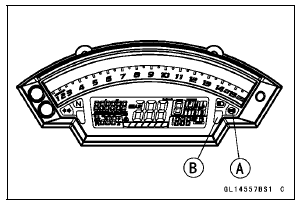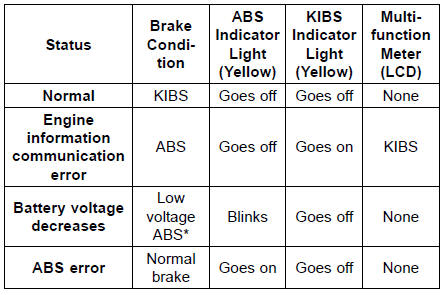

In this model, the ABS indicator light (LED) [A] and KIBS indicator light (LED) [B] go on or blink by the data sent from the KIBS hydraulic unit.

ABS and KIBS Indicator Lights (LED) Function

*: The mode of “Low voltage ABS” controls ABS while reducing the load to the battery.
NOTE
When the ABS indicator light is blinking, the ABS has been in the low voltage mode (insufficient battery voltage).
When it is in the low voltage mode, the KIBS system does not function, but the ABS functions. To recover the KIBS system, charge the battery. (see Refreshing Charge in the Electrical System chapter).
 Inquiries to Rider
Inquiries to Rider KIBS Hydraulic Unit Removal
KIBS Hydraulic Unit RemovalOperational Cautions
1. Do not put two keys of any immobilizer system on the same key ring.
2. Do not submerge any key in water.
3. Do not expose any key to excessively high temperature.
4. Do not place any key close to magnet.
5. Do not place a heavy item on any key.
6. Do not grind any key or alter its ...
Piston Ring, Piston Ring Groove Wear Inspection
Check for uneven groove wear by inspecting the ring seating.
The rings should fit perfectly parallel to groove surfaces.
If not, replace the piston and all the piston rings.
With the piston rings in their grooves, make several measurements
with a thickness gauge [A] to determine pisto ...
Special Tools
Fork Oil Level Gauge:
57001-1290
Vacuum Gauge:
57001-1369
Hand Tester:
57001-1394
Throttle Sensor Setting Adapter #1:
57001-1400
Peak Voltage Adapter:
57001-1415
Needle Adapter Set:
57001-1457
Throttle Sensor Setting Adapter:
57001-1538
Measuring Adapter:
57001-1700
...